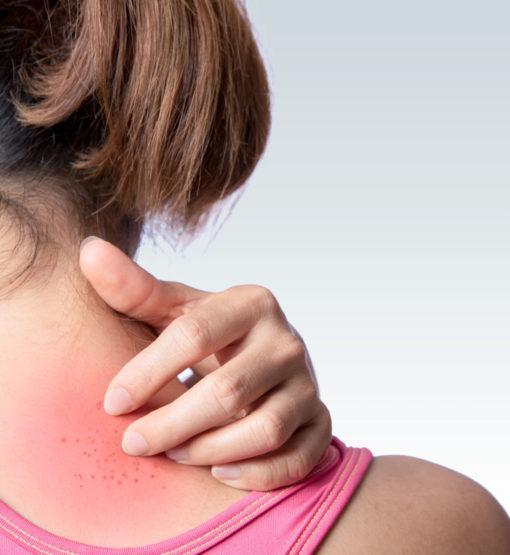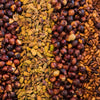Keto Rash: Why Your Ketogenic Diet Makes You Itch (And How to Fix It)

Does ketosis make you itchy?
You likely have the “keto rash,” which is a preventable and treatable skin irritation that's a normal (albeit annoying) side effect of starting the ketogenic diet.
What Is the Keto Rash?
Keto rash is an uncommon inflammatory skin condition that comes with a scary-sounding name “prurigo pigmentosa” (pigmented irritation). Prurigo pigmentosa is also called the “Nagashima disease,” after the Japanese town where it was first reported in 1971.[1]While the origin and exact reasons for the rash remains unknown (scientists are actively researching it), it’s commonly present on people who are in the first stages of ketosis.
According to a 2017 review [2] with 83 patients for Korea and 53 for Japan, 84.3% of the cases occurred between 11 and 30 years of age with the mean age of 24.4 years. In the same study, the female to male ratio was 2:6 while another research concluded it at 14:2 [3]. So, the disease affects female teenagers and young adults more commonly.
Other studies have shown that prurigo pigmentosa occurs on people with uncontrolled diabetes as well as those who fast or follow low carb diets (like keto). Keto rash also appeared on the skin of a patient who had gone through bariatric (weight loss) surgery.
What Are the Symptoms?
Prurigo pigmentosa looks similar to dermatitis and eczema with its symptoms typically occurring on the torso, back, chest, neck, shoulders and underarms in the form of itchy, raised skin lesions. The disease usually forms a symmetrical pattern on each side of the body with a web-like appearance.Keto rash can be red, brown or light pink in color (it depends on the current stage of the disease). In rare cases, the disease might appear on face and extremities.
The disease comes with an uncomfortable feeling, but its symptoms are not life-threatening at all. But, you shouldn’t expose the rash to heat, moisture and friction or exercise extremely as the symptoms can worsen in these cases.
The Stages of Keto Rash
According to a study [4], keto rash has four stages.The first one is early lesions where light pink raised skin lesions called “urticarial papuloplaques” appear on the skin. While the symptoms look like scratch marks or a temporary rash, you shouldn’t neglect them as keto rash can advance to the next stages.
The second stage comes with fully developed lesions that often worries people that have them. The red skin lesions (called papules) are more aggressive than in the first stage and sometimes they include liquid-filled cysts (papulovesicles). In more rare cases, the papules are filled with pus (papulopustules).

Source: Journal of the European Academy of Dermatology and Venereology
After a while, the lesions will start to resolve. In this stage, patients can observe that the papules are crusty, and scaly while starting to become darker.

Source: Journal of the European Academy of Dermatology and Venereology
The final stage is called late lesions when the skin is left with a web-like appearance consisting of dark spots that are larger than freckles. This phenomenon is called “reticulated hyperpigmentation” that might remain long after the rash is healed.

Source: Journal of the European Academy of Dermatology and Venereology
How Long Does Keto Rash Last?
The time it takes for the rash to go away varies by person. For some patients, it can linger for a couple of weeks, while the rash can last for several months for other, less fortunate persons. The last two stages of the disease last the longest.In the best-case scenario, your skin heals within a couple of weeks without the need for treatment.
But, in the worst-case scenario, you are in a small group of people who get keto rash every time your body enters ketosis. Even in this case, there’s still no reason to worry. Later in this article, we’ll show you how you can cure and even prevent the disease from appearing.
The Causes of Keto Rash
Researchers have found a link between ketosis and prurigo pigmentosa [5] [6] [7] [8]. But, they are yet to find the exact cause of the disease. We’ve listed the potential causes that could trigger keto rash for keto-ers:- Excessive fasting. When blood sugar levels are low during a fast, ketosis can commence that could trigger the disease. A study shows the keto rash found at 50% of the patients could be due to fasting [9].
- Ketones. During ketosis, your body produces ketones (e.g., acetone) that can cause inflammation around your blood vessels (perivascular inflammation) that can result in the rash appearing on your skin [10].
- Low carb diet [10]. Weight loss on keto is a normal and usually welcome side effect but researchers have connected low carb diets that cause rapid weight loss in a short amount of time to keto rash.
- Nutrient deficiency. Excluding entire food groups from your diet can result in nutrient deficiency and prurigo pigmentosa.
- Allergens. Some keto-friendly foods can trigger allergic reactions that can eventually lead to keto rash.
- External irritants. According to a study, potential skin irritants like chlorinated pool water and acetone might also trigger the rash.
- Restarting the diet. Five patients in the study got prurigo pigmentosa again after they went back to their diet (e.g., low carb diets, ketosis). If you are like these patients, keto rash might reappear on your skin if you stay in ketosis for too long.
- Mechanical irritation. Another five patients developed the rash again after their skin was affected by mechanical irritation (friction from clothing, body-scrubbing, bandage).
- Sweating due to hot weather or exercise (3 patients).
- Emotional stress caused the rash to re-appear in the cases of 2 patients.
How to Cure Keto Rash
As researchers don’t know the exact cause of keto rash, the most effective treatment of the disease remains unknown.But, we’ve collected the best cures for prurigo pigmentosa that will likely help you in getting rid of keto rash.
#1: Give it Some Time to Heal
Within a few weeks, keto rash might heal on its own without any treatment. This cure especially works when you are new to keto. As the diet is a major lifestyle change with you leaving out complete food groups, your body needs some time to adjust.The longer you are in ketosis, the more your body adapts to the production ketones. The same had happened with the participants of a research [10] whose lesions have disappeared within a few weeks after no treatment.
Although, if this method does not work for you, then you shouldn’t be waiting for a miracle. You have other options, let’s explore them.
#2. Increase Your Carb Intake
According to a study [3], keto the rash appeared on eight out of 16 patients who fasted for a long period of time as well as on six patients who were in ketosis. A different study [10] shows that the disease’s suspected trigger was dietary change (ketosis, fasting or low carb diet) for 17 people out of 50.Therefore, you need to test whether your new ketogenic diet is the trigger for the rash. To do that, you need to:
- Increase your carb intake to a level that will get you out of ketosis for a few days. Check whether you still have the rash.
- If it disappears, enter ketosis again by lowering your carbohydrate consumption.
- If the rash reappears, then your body might be sensitive to ketones.
3. Eliminate Allergens From Your Diet
As you have changed your diet drastically, the risk of food allergy exposure increases. Therefore, you should test whether your newly introduced keto-friendly foods are responsible for your skin disease.Here’s a short list of the most common keto-friendly foods that could trigger allergies:
- Dairy (e.g., full-fat yogurt, cottage cheese, hard cheese)
- Eggs
- Shellfish (e.g., oysters, clams, crab)
- Fish (e.g., tuna, salmon)
- Peanuts
- Tree nuts (e.g., macadamia, almonds)
- Remove all of the food groups listed in this section for 3-4 weeks.
- Check whether your rash has disappeared.
- If it has, introduce only one of the food groups and see what happens in 1-2 weeks.
- If your rash hasn’t reappeared, continue to add a new food group every 1-2 weeks.
- If the keto rash resurfaces after adding a food group, then you have successfully found your trigger. Leave that food group out of your diet permanently.
4. Vitamin and Mineral Supplements
Deficiency could also be the cause of your rash. That’s why you want to rule that out by supplementing your diet with vitamins, minerals and other nutrients:- Minerals: sodium, potassium, magnesium, calcium. The level of these minerals can decrease soon after you have started your keto diet. As they are vital for energy and cell-function, you need to add these supplements to your diet.
- Vitamins: Omega-3, vitamin D, vitamin A. Keto rash is an inflammatory response and these vitamins are great for regulating inflammation.
- Bile salts: cholic, deoxycholic, chenodeoxycholic and lithocholic acids. As keto is a high-fat diet, you need supplements that help your liver process large amounts of fat properly. And choosing bile salts is a good solution for that.
- Water: You always need to make sure to drink enough water. Many keto-ers lose a lot of liquid when they first start the diet that can increase the concentration of acetone in the sweat. And, as mentioned before, acetone might be a trigger for the rash.
5. Talk to Your Doctor About Antibiotics as a Last Resort
Multiple studies [3] [11] [12] have found that certain types of antibiotics are highly effective in curing keto rash. But, you should keep in mind that the indiscriminate use of antibiotics is harmful, so this option should be your last resort.Researchers have found that these antibiotics are the best for keto rash treatment:
- Minocycline
- Doxycycline
- Dapsone (researchers prefer minocycline over dapsone as it has fewer side effects as well as it results in a longer remission)
How to Prevent Keto Rash
While the exact methods remain unknown, keto rash still can be prevented. We’ve collected a few tips that you can use to avoid the disease:- Transition into ketosis slowly. As mentioned before in this article, a drastic diet change can come with some side effects. Dropping your carb consumption to a very low level in a short period of time has a higher chance for developing keto rash than a slow, gradual transition.
- Pay attention to even the slightest rash symptoms. As soon as you discover a symptom of the disease, increase your carbohydrate intake to prevent the rash from progressing to more advanced stages.
- Supplement. You should always supplement your diet with nutrients (minerals, vitamins, etc.) to avoid deficiencies.
Remember that keto rash is rare, so there’s only a slight chance that it will appear on your skin.
Even after it appears, you can use the simple ways in this article to cure it and even prevent it from developing. Keto rash shouldn’t discourage you from harnessing the benefits of the ketogenic diet.
References:
- https://www.ncbi.nlm.nih.gov/pubmed/21929552
- https://www.ncbi.nlm.nih.gov/pubmed/27533074
- https://www.ncbi.nlm.nih.gov/pubmed/21929552
- https://www.ncbi.nlm.nih.gov/pubmed/21929552
- http://onlinelibrary.wiley.com/doi/10.1111/j.1365-2133.1996.tb07643.x/abstract
- http://onlinelibrary.wiley.com/doi/10.1111/j.1346-8138.2012.01640.x/full
- http://onlinelibrary.wiley.com/doi/10.1111/j.1468-3083.2011.04263.x/abstract
- http://www.jaad.org/article/S0190-9622(96)90460-0/fulltext
- https://www.ncbi.nlm.nih.gov/pubmed/21929552
- http://onlinelibrary.wiley.com/doi/10.1111/j.1346-8138.2012.01640.x/full
- https://www.ncbi.nlm.nih.gov/pubmed/26334426
- https://www.ncbi.nlm.nih.gov/pubmed/27533074
-
Posted in
Authority Article, keto rash, Keto Side Effects, rash, Starting Keto




